 Published in 2020 by Windmill Books, an imprint of Rosen Publishing 29 East 21st Street, New York, NY 10010 Copyright 2020 Miles Kelly Publishing All rights reserved. No part of this book may be reproduced in any form without permission in writing from the publisher, except by a reviewer. Publishing Director: Belinda Gallagher Creative Director: Jo Cowan Editorial Director: Rosie Neave Design Manager: Joe Jones Consultant: Anne Rooney Indexer: Marie Lorimer Image Manager: Liberty Newton Production: Elizabeth Collins, Jennifer Brunwin-Jones Reprographics: Stephan Davis Assets: Lorraine King Cataloging-in-Publication Data Names: Steele, Philip. Title: Project weather / Philip Steele. Description: New York: Windmill Books, 2020. | Series: The project makers | Includes index.
Published in 2020 by Windmill Books, an imprint of Rosen Publishing 29 East 21st Street, New York, NY 10010 Copyright 2020 Miles Kelly Publishing All rights reserved. No part of this book may be reproduced in any form without permission in writing from the publisher, except by a reviewer. Publishing Director: Belinda Gallagher Creative Director: Jo Cowan Editorial Director: Rosie Neave Design Manager: Joe Jones Consultant: Anne Rooney Indexer: Marie Lorimer Image Manager: Liberty Newton Production: Elizabeth Collins, Jennifer Brunwin-Jones Reprographics: Stephan Davis Assets: Lorraine King Cataloging-in-Publication Data Names: Steele, Philip. Title: Project weather / Philip Steele. Description: New York: Windmill Books, 2020. | Series: The project makers | Includes index.
Identifiers: ISBN 9781538392409 (pbk.) | ISBN 9781725393080 (library bound) | ISBN 9781538392416 (6 pack) Subjects: LCSH: Weather--Experiments--Juvenile literature. | Meteorology--Experiments- -Juvenile literature. | Weather--Juvenile literature. | Science projects--Juvenile literature. Classification: LCC QC981.3 S744 2019 | DDC 551.5078--dc23 Manufactured in the United States of America CPSIA Compliance Information: Batch #BW20WM: For Further Information contact Rosen Publishing, New York, New York at 1-800-237-9932 How to use the projects This book is packed full of amazing facts about weather. There are also 11 cool projects, designed to make the subject come alive.Before you start a project:Always ask an adult to help you.Read the instructions carefully.Gather all the supplies you need.Clear a surface to work on and cover it with newspaper.Wear an apron or old T-shirt to protect your clothing.Notes for helpers:Children will need supervision for the projects, usually because they require the use of scissors, or preparation beforehand.Read the instructions together before starting and help to gather the equipment. IMPORTANT NOTICE The publisher and author cannot be held responsible for any injuries, damage, or loss resulting from the use or misuse of any of the information in this book.
SAFETY FIRST! Be careful when using glue or anything sharp, such as scissors.  CONTENTS Chart the weather Build a weather vane Water cycle in action Cloud in a jar Rain gauge Track a thunderstorm Which freezes first? Measure the temperature Build a barometer Make a solar oven Be a weather historian
CONTENTS Chart the weather Build a weather vane Water cycle in action Cloud in a jar Rain gauge Track a thunderstorm Which freezes first? Measure the temperature Build a barometer Make a solar oven Be a weather historian  What is weather? Our planet is surrounded by air. This layer of gases is known as the atmosphere, and the way it behaves from one day to the next is called the weather. Will it be rainy, sunny, windy - or will it snow? The weather changes all the time as heat from the Sun interacts with land, sea, and air.
What is weather? Our planet is surrounded by air. This layer of gases is known as the atmosphere, and the way it behaves from one day to the next is called the weather. Will it be rainy, sunny, windy - or will it snow? The weather changes all the time as heat from the Sun interacts with land, sea, and air.  Blow by blow Earths atmosphere isnt the same all over. Some air masses are warm, others are cold.
Blow by blow Earths atmosphere isnt the same all over. Some air masses are warm, others are cold.
Some are at high pressure, others are at low pressure - meaning they press against surfaces with varying force. Winds are caused by differences in temperature and pressure that make air rush from one area into another.  Water goes around Earth can support life because it has huge amounts of water. It has salty oceans and seas, and freshwater lakes and rivers. Water moves endlessly from land and sea into the air and back again. This process is called the water cycle.
Water goes around Earth can support life because it has huge amounts of water. It has salty oceans and seas, and freshwater lakes and rivers. Water moves endlessly from land and sea into the air and back again. This process is called the water cycle.
It helps create our weather systems.  Head in the clouds Clouds appear when water vapor cools and condenses, turning back into liquid. They are made up of water droplets or ice crystals that are so tiny they float in the air. The drops often form around specks of dust or pollen and may be blown along by wind. As they join and become heavier, they fall as snowflakes or raindrops.
Head in the clouds Clouds appear when water vapor cools and condenses, turning back into liquid. They are made up of water droplets or ice crystals that are so tiny they float in the air. The drops often form around specks of dust or pollen and may be blown along by wind. As they join and become heavier, they fall as snowflakes or raindrops. 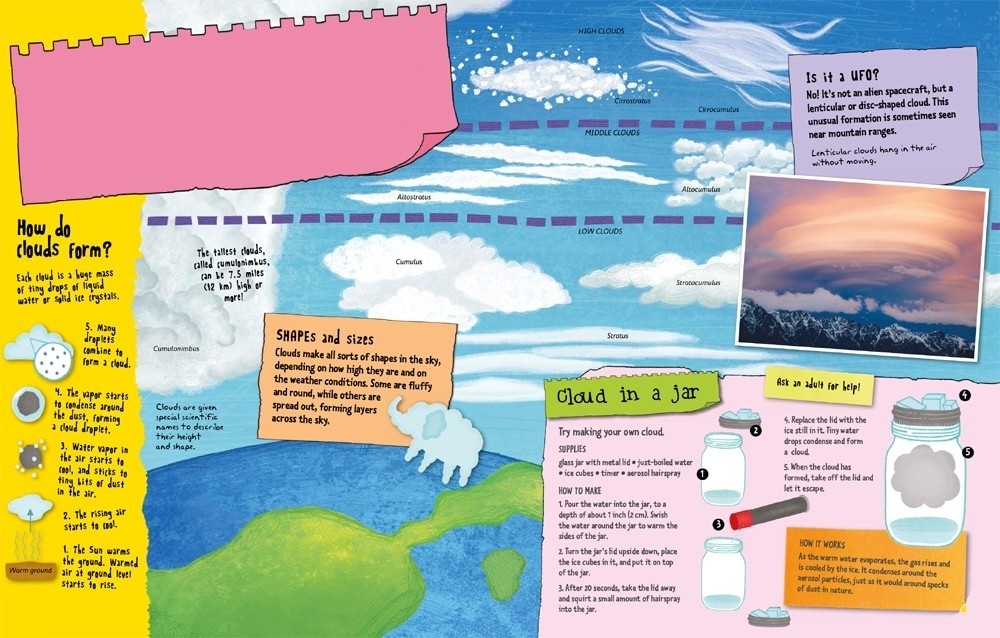 Rainy days We may not like rainy days very much, unless they come at the end of a hot, dry spell.
Rainy days We may not like rainy days very much, unless they come at the end of a hot, dry spell.
But freshwater keeps us all alive. Rainwater makes crops grow, and keeps large areas of our planet fresh and green. It fills rivers and lakes. 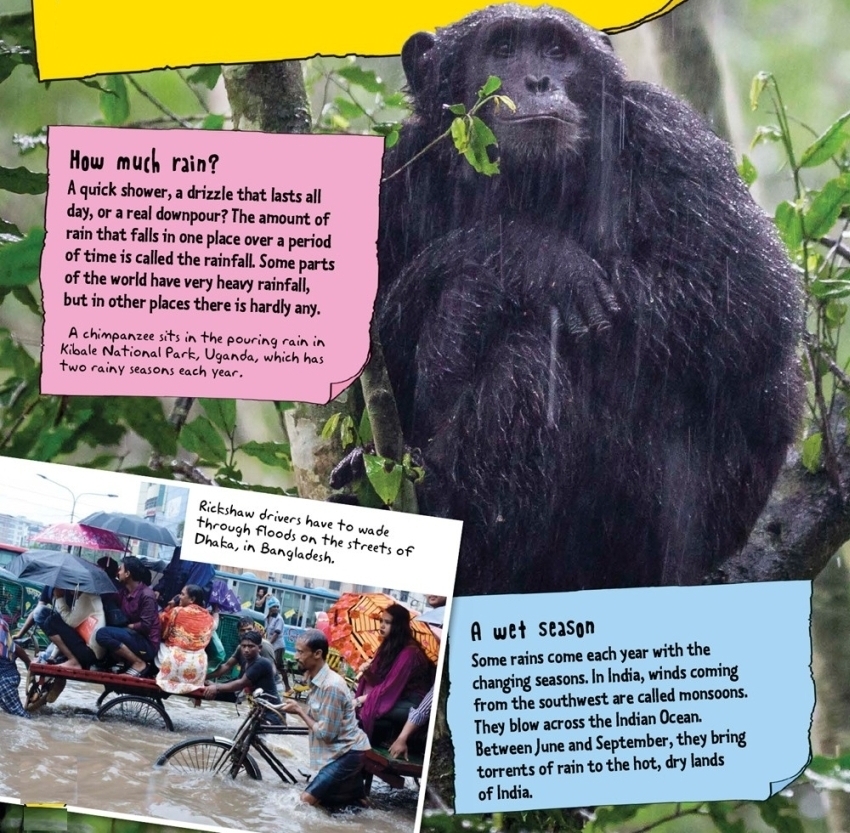
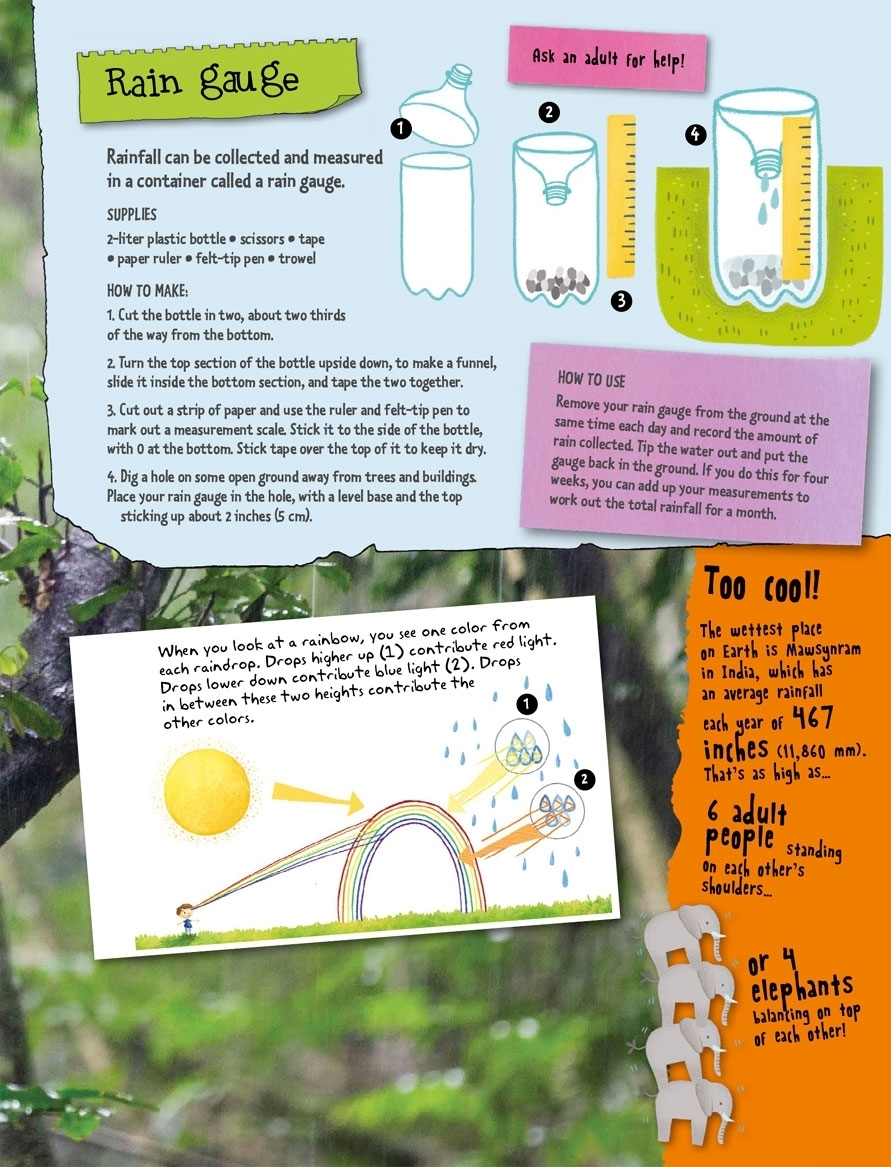 AROUND THE WORLD The world can be divided into climate zones, according to regular weather patterns within regions. Each zone supports different plants and animals.
AROUND THE WORLD The world can be divided into climate zones, according to regular weather patterns within regions. Each zone supports different plants and animals. 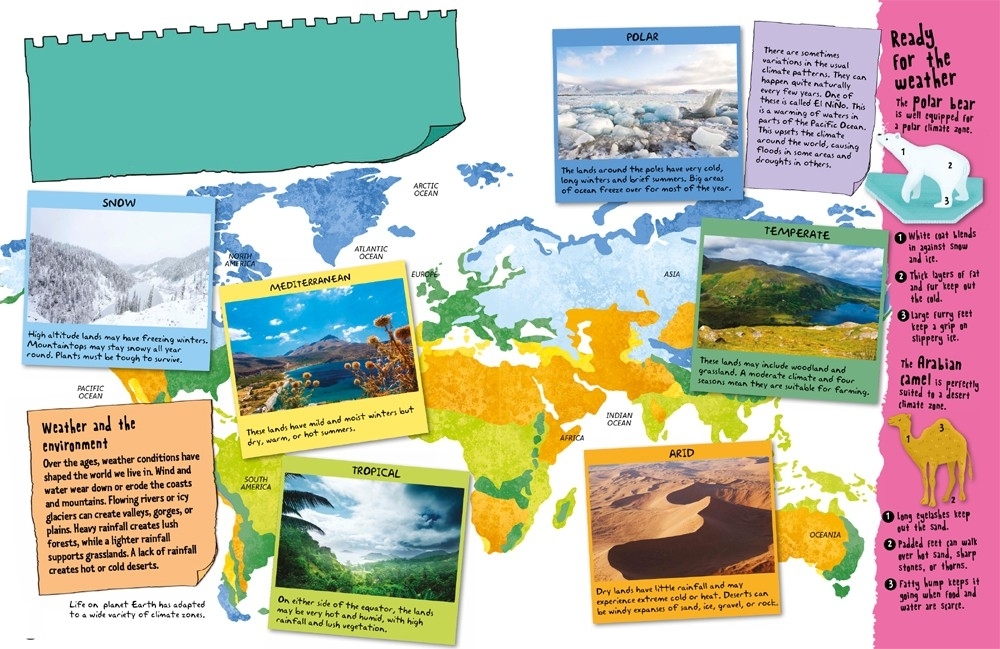 RED ALERT! Bad and fine weather are part of normal conditions on our planet.
RED ALERT! Bad and fine weather are part of normal conditions on our planet.  RED ALERT! Bad and fine weather are part of normal conditions on our planet.
RED ALERT! Bad and fine weather are part of normal conditions on our planet.
More unusual weather events are caused by powerful disturbances in Earths atmosphere. Some types of bad weather are more common in some climate zones than in others. When weather becomes extreme it can be dangerous, putting lives at risk. 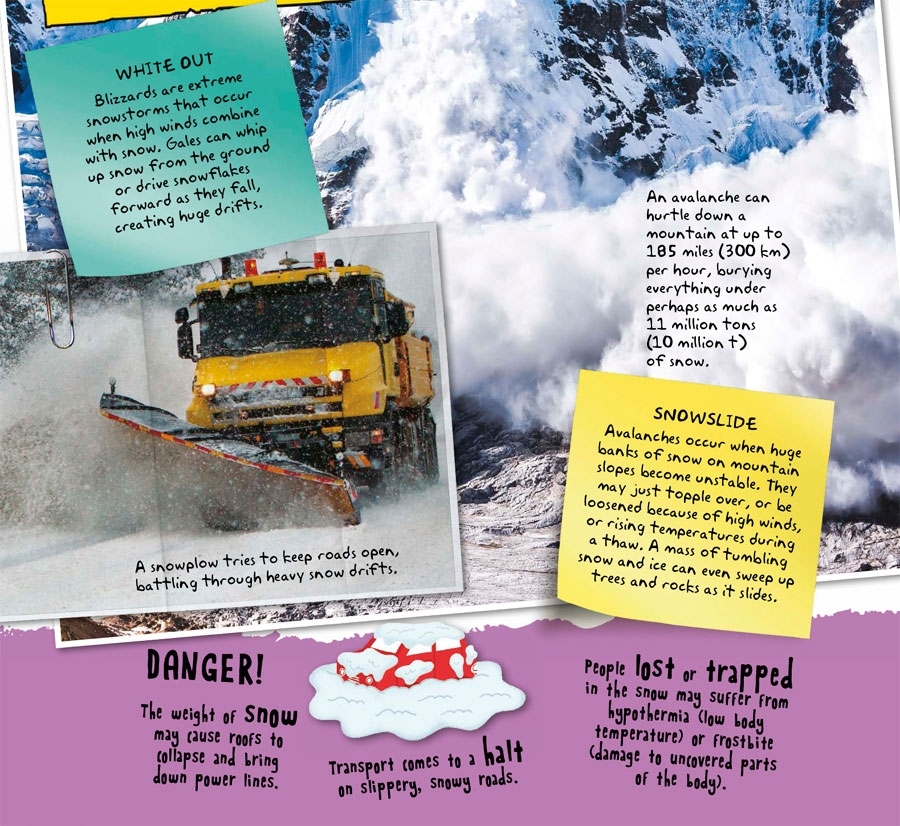
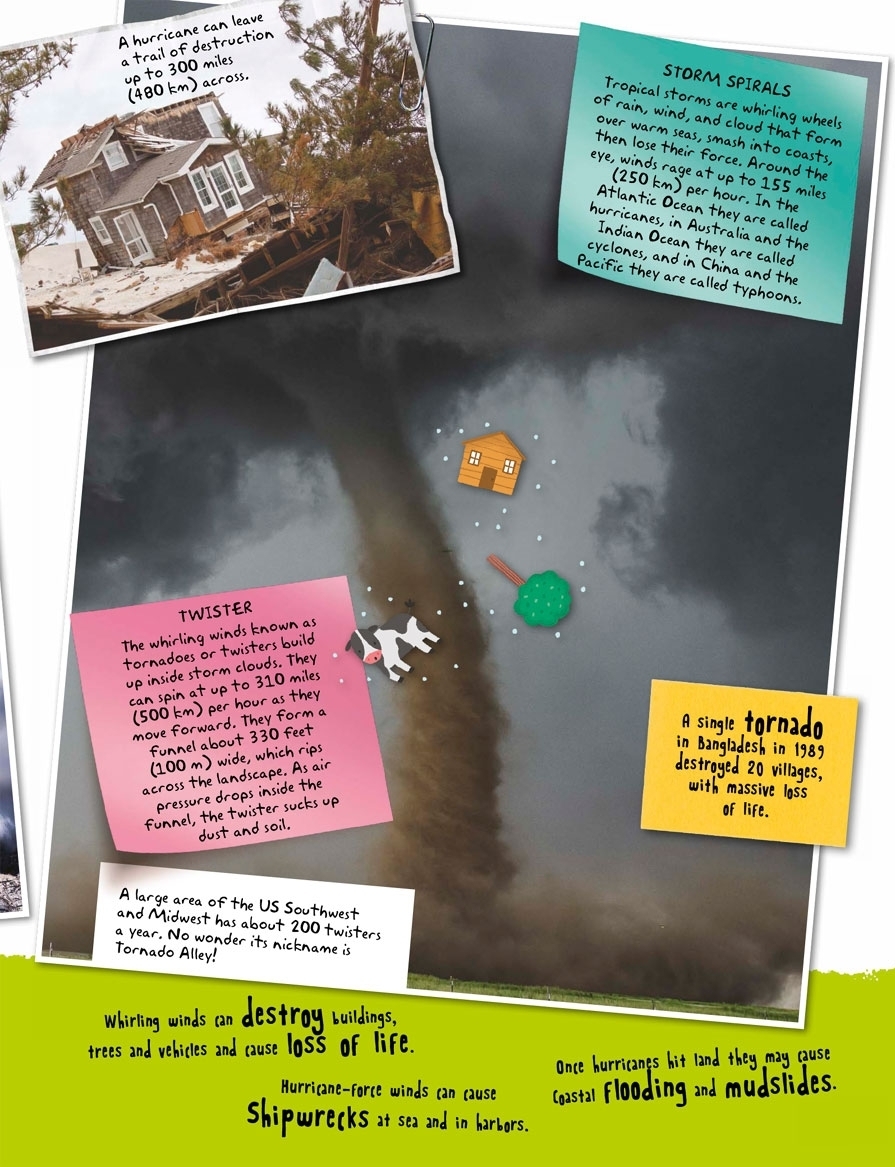
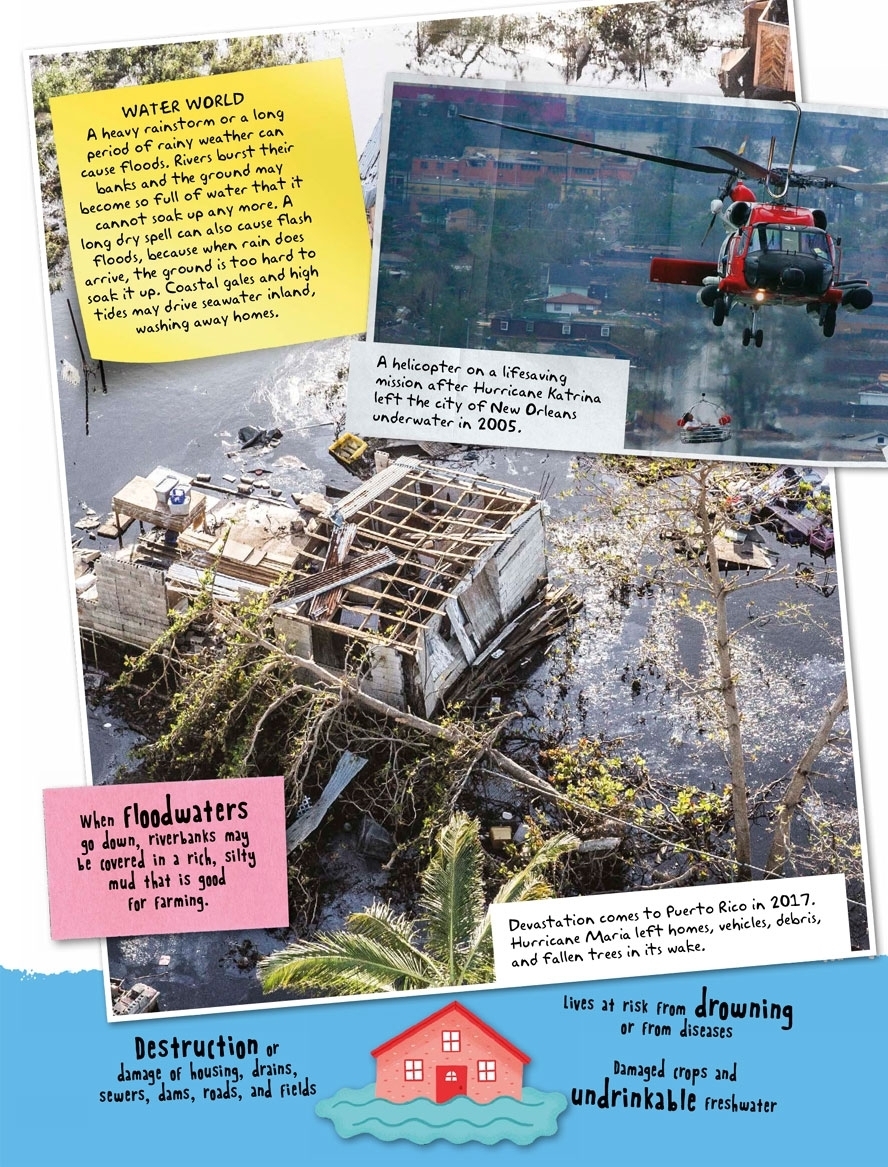
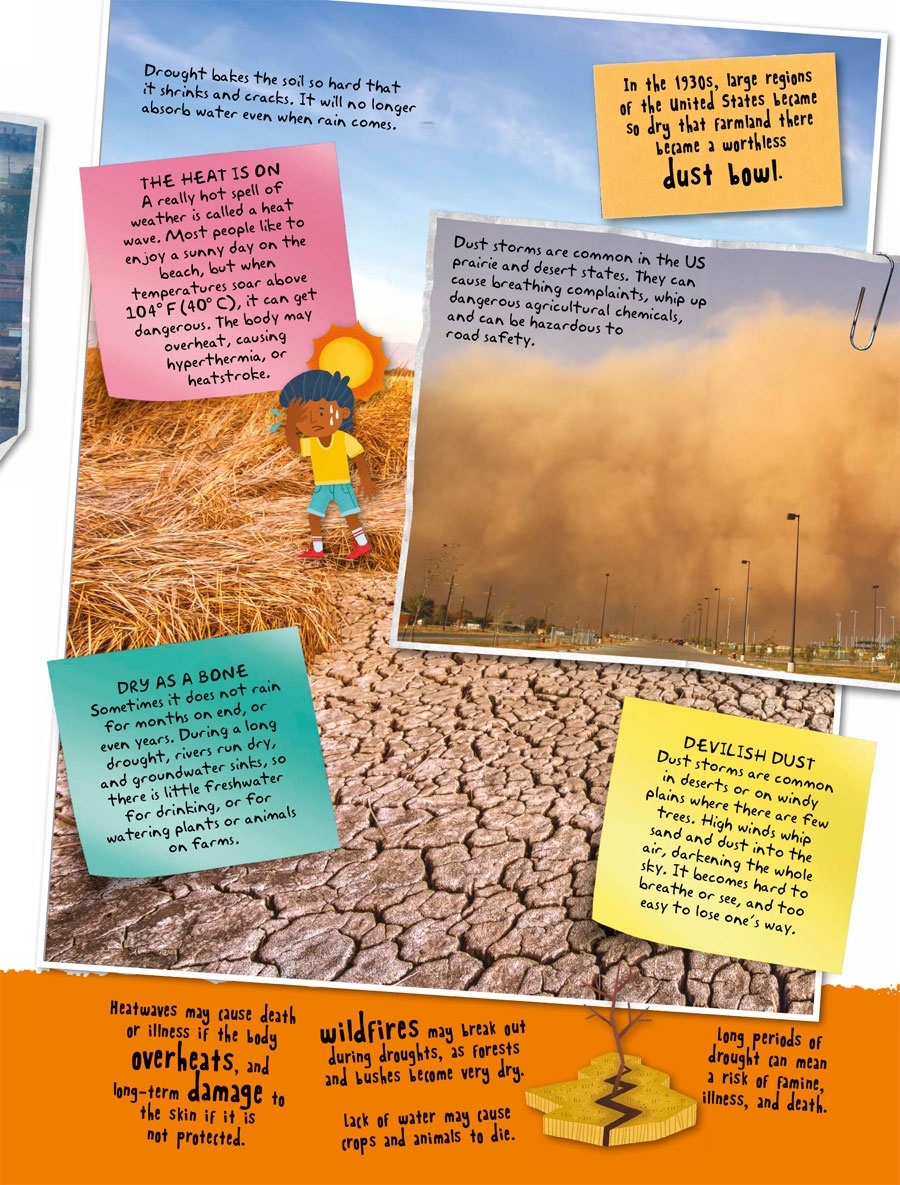 Flash, bang, wallop! Long ago, people thought that the winds, rain, and sunshine were all the work of gods or goddesses. Thunder and lightning were supposed to be battles fought by angry gods as they crossed the stormy sky.
Flash, bang, wallop! Long ago, people thought that the winds, rain, and sunshine were all the work of gods or goddesses. Thunder and lightning were supposed to be battles fought by angry gods as they crossed the stormy sky. 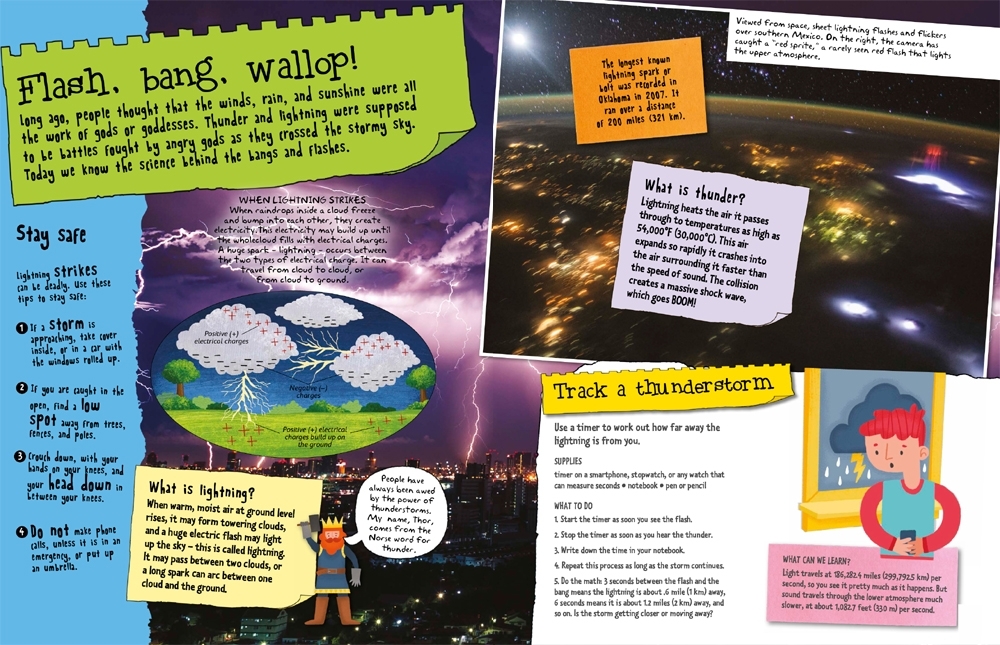 Brrrrr! Water turns from liquid to solid when it freezes, which happens at 32F (0C).
Brrrrr! Water turns from liquid to solid when it freezes, which happens at 32F (0C).  Brrrrr! Water turns from liquid to solid when it freezes, which happens at 32F (0C).
Brrrrr! Water turns from liquid to solid when it freezes, which happens at 32F (0C).
In cold weather, puddles, rivers, and lakes freeze over. The weather needs to be really cold before the sea freezes over - find out why this is by completing the experiment on the opposite page. 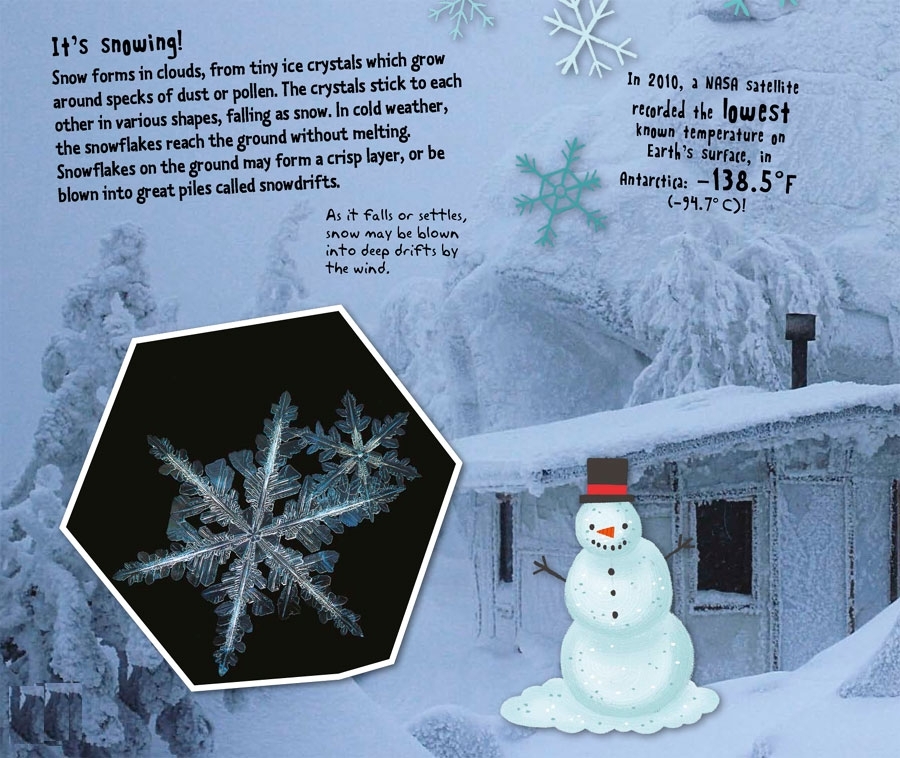
Next page

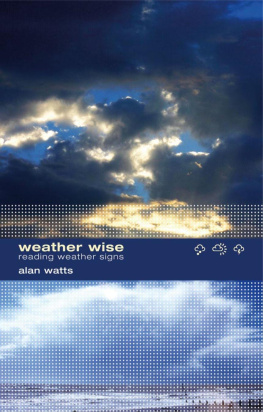




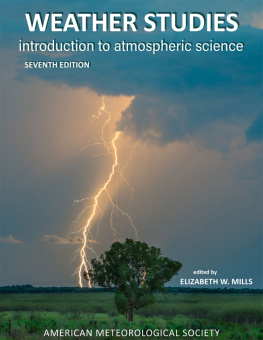
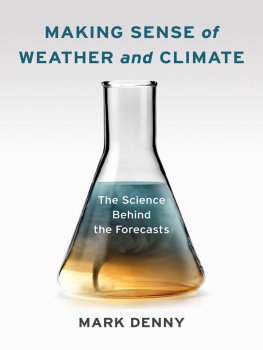

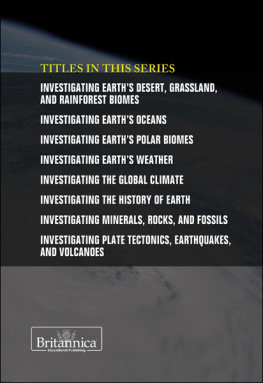
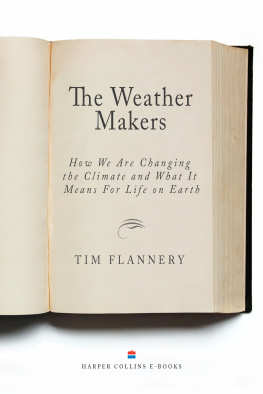
 Published in 2020 by Windmill Books, an imprint of Rosen Publishing 29 East 21st Street, New York, NY 10010 Copyright 2020 Miles Kelly Publishing All rights reserved. No part of this book may be reproduced in any form without permission in writing from the publisher, except by a reviewer. Publishing Director: Belinda Gallagher Creative Director: Jo Cowan Editorial Director: Rosie Neave Design Manager: Joe Jones Consultant: Anne Rooney Indexer: Marie Lorimer Image Manager: Liberty Newton Production: Elizabeth Collins, Jennifer Brunwin-Jones Reprographics: Stephan Davis Assets: Lorraine King Cataloging-in-Publication Data Names: Steele, Philip. Title: Project weather / Philip Steele. Description: New York: Windmill Books, 2020. | Series: The project makers | Includes index.
Published in 2020 by Windmill Books, an imprint of Rosen Publishing 29 East 21st Street, New York, NY 10010 Copyright 2020 Miles Kelly Publishing All rights reserved. No part of this book may be reproduced in any form without permission in writing from the publisher, except by a reviewer. Publishing Director: Belinda Gallagher Creative Director: Jo Cowan Editorial Director: Rosie Neave Design Manager: Joe Jones Consultant: Anne Rooney Indexer: Marie Lorimer Image Manager: Liberty Newton Production: Elizabeth Collins, Jennifer Brunwin-Jones Reprographics: Stephan Davis Assets: Lorraine King Cataloging-in-Publication Data Names: Steele, Philip. Title: Project weather / Philip Steele. Description: New York: Windmill Books, 2020. | Series: The project makers | Includes index. CONTENTS Chart the weather Build a weather vane Water cycle in action Cloud in a jar Rain gauge Track a thunderstorm Which freezes first? Measure the temperature Build a barometer Make a solar oven Be a weather historian
CONTENTS Chart the weather Build a weather vane Water cycle in action Cloud in a jar Rain gauge Track a thunderstorm Which freezes first? Measure the temperature Build a barometer Make a solar oven Be a weather historian  What is weather? Our planet is surrounded by air. This layer of gases is known as the atmosphere, and the way it behaves from one day to the next is called the weather. Will it be rainy, sunny, windy - or will it snow? The weather changes all the time as heat from the Sun interacts with land, sea, and air.
What is weather? Our planet is surrounded by air. This layer of gases is known as the atmosphere, and the way it behaves from one day to the next is called the weather. Will it be rainy, sunny, windy - or will it snow? The weather changes all the time as heat from the Sun interacts with land, sea, and air.  Blow by blow Earths atmosphere isnt the same all over. Some air masses are warm, others are cold.
Blow by blow Earths atmosphere isnt the same all over. Some air masses are warm, others are cold. Water goes around Earth can support life because it has huge amounts of water. It has salty oceans and seas, and freshwater lakes and rivers. Water moves endlessly from land and sea into the air and back again. This process is called the water cycle.
Water goes around Earth can support life because it has huge amounts of water. It has salty oceans and seas, and freshwater lakes and rivers. Water moves endlessly from land and sea into the air and back again. This process is called the water cycle. Head in the clouds Clouds appear when water vapor cools and condenses, turning back into liquid. They are made up of water droplets or ice crystals that are so tiny they float in the air. The drops often form around specks of dust or pollen and may be blown along by wind. As they join and become heavier, they fall as snowflakes or raindrops.
Head in the clouds Clouds appear when water vapor cools and condenses, turning back into liquid. They are made up of water droplets or ice crystals that are so tiny they float in the air. The drops often form around specks of dust or pollen and may be blown along by wind. As they join and become heavier, they fall as snowflakes or raindrops.  Rainy days We may not like rainy days very much, unless they come at the end of a hot, dry spell.
Rainy days We may not like rainy days very much, unless they come at the end of a hot, dry spell.
 AROUND THE WORLD The world can be divided into climate zones, according to regular weather patterns within regions. Each zone supports different plants and animals.
AROUND THE WORLD The world can be divided into climate zones, according to regular weather patterns within regions. Each zone supports different plants and animals.  RED ALERT! Bad and fine weather are part of normal conditions on our planet.
RED ALERT! Bad and fine weather are part of normal conditions on our planet. 


 Flash, bang, wallop! Long ago, people thought that the winds, rain, and sunshine were all the work of gods or goddesses. Thunder and lightning were supposed to be battles fought by angry gods as they crossed the stormy sky.
Flash, bang, wallop! Long ago, people thought that the winds, rain, and sunshine were all the work of gods or goddesses. Thunder and lightning were supposed to be battles fought by angry gods as they crossed the stormy sky.  Brrrrr! Water turns from liquid to solid when it freezes, which happens at 32F (0C).
Brrrrr! Water turns from liquid to solid when it freezes, which happens at 32F (0C). 